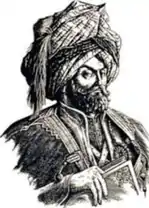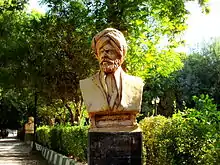Sharafkhan Bidlisi
Sharaf al-Din Khan b. Shams al-Din b. Sharaf Beg Bedlisi (Kurdish: شەرەفخانی بەدلیسی, Şerefxanê Bedlîsî; Persian: شرفالدین خان بن شمسالدین بن شرف بیگ بدلیسی) (949-1012/ 25 February 1543)[1] was a medieval Kurdish Emir of the Emirate of Bitlis. But he is more known as a historian, writer and poet. He wrote exclusively in Persian. Born in the Garmrood village, in central Iran, between Arak and Qom, at a young age he was sent to the Safavid's court and obtained his education there.
| Sharaf Khan Bidlisi Şerefxanê Bedlîsî شەرەفخانی بەدلیسی | |||||
|---|---|---|---|---|---|
| Emir, Mir and Khan | |||||
 A portrait of Sharaf Khan Bidlisi | |||||
| Reign | Emirate of Bitlis | ||||
| Successor | Shamsaddin Bag Abu Alma'ali | ||||
| Born | February 25, 1543 | ||||
| Died | 1603 (60 years) | ||||
| |||||
| Dynasty | Bitlisi dynasty | ||||
| Father | Shamsaddin Batlisi | ||||
| Religion | Islam | ||||

He is the author of Sharafnama, one of the most important works on medieval Kurdish history, written in 1597.[2] He created a good picture of Kurdish life and Kurdish dynasties in the 16th century in his works. Outside Iran and Kurdish-speaking countries, Sharaf Khan Bidlisi has influenced Kurdish literature and societies through the translation of his works by other scholars.
He was also a gifted artist, and a well-educated man excelling as much in mathematics and military strategy, as he did in history.
Early life
Sharaf Khan Bidlisi was born on February 25, 1543, in the Markazi province, Iran in the Garmrood village, during the exile of his father. The Rojaki dynasty, which had ruled intermittently as an independent emirate from their capital of Bitlis since at least the 9th century, and therefore, he never took up the common tribal title of "Khan", preferring instead the royal title of emir or mir, "prince." He was most commonly known as, Mir Sharaf (Prince Sharaf). Later his family was taken under protection of the Safavid dynasty.[3] He was schooled at Tahmasb's court, and wrote in 1596:
"When I turned nine (in 1551) I entered the private harem (haram-i khass)... for three years (1551–1554) I served the family (Silsila) of that refined (pakiza atvar) shah as a page at the inner palace."
— Sharaf Khan Bidlisi
Bedlîsî speaks of his education entailing instruction in the Quran, readings in on the principles of the shari'a, a piety and purity. Due to Shah Tahmasb's religious disposition, Bidlisi was introduced to religious scholars, who warned him against evil people, and instead encouraged friendship with the virtuous. And once Bidlisi attained maturity, he was thought the martial arts (sipahigira), archery, polo, racing, swordsmanship, and the precepts of chivalry – humanism and generosity.[4]
In 1576 Tahmasb of the Safavids gives him the title the Mir of Mirs; appoints him leader of all Iranian Kurdish tribes.[5] He accepts his title, but only two years later, Sharafkhan abandons his previous stand, and supports the Ottomans in their war against the Iranians, offering them 400 soldiers. In 1578, Sultan Murad III, the Ottoman Sultan, grants Sharafkhan the title of Emir and he becomes the Mir of the Emirate of Bitlis.[6] Between 1578 and 1588, Sharafkhan virtually led all the Ottoman wars against the Persians.[7] In 1597, Sharafkhan gave the authority of his dynasty to his son Šams-al-Dīn.[1]
Sharafnama
He was thinking for a long time to write a book about Kurdish history, and finally in 1597 Sharaf Khan Bidlisi started his composition of his epic, Sharafnama.The Sharafnama divides its history into four parts. The first one deals with the five Kurdish dynasties that have enjoyed status as royalty (Saltant): the Marwanids of Amed, the Hasanwayhids of Dinavar and Sharizur, the Fadluyids of the Great Lur, the princes of little Lur, and finally, Saladin the Great and the Ayyubids. The second part lists dynasties that have had coin struck and the khutba recited in their names. (The Khutba is a religious invacation pronounced at the Friday day prayers meeting that mentions the Prophet, the first four caliphs and the current rulers). The third part numbers the families of the hereditary governors, while the fourth details the history of the mirs of Bitilis.[8]
He wrote his works in Persian, and it was not until 1879 that it was translated into Kurdish (Kurmanji) by the Kurdish polymath Mahmud Bayazidi (1797–1859). Its hand-written version is preserved in the Russian National Library, and was published for the first time in 1986. In 1972, the Sorani version of Sharafnama was written for the first time by the late Kurdish scholar Abdurrahman Sharafkandi (1920–1991), also known as Mamosta Hajar. In 1873–1875, the French scholar François Charmoy translated Sharafnama from Persian into French and published it in Saint Petersburg, in Russia. Among many other languages, Sharafname has been translated into Arabic, English, Turkic languages, Russian, Greek and Armenian.
Death
He died in his own principality (Emirate of Bitlis) in 1603 at the age of 60, and left thousands of writings.
Legacy
The creation of Sharafnama, one of the oldest books ever written by a Kurd, is a turning point in the history of Kurds and their rich culture. The fact that a Kurd, for the first time, put Kurdish culture under a spotlight is of special importance in contrast to other studies that were done before Sharafnama.
Bidlisi has a unique place in Kurdish history. After his Sharafnama, a number of copies and other works similar in nature surfaced over the centuries within the cultural sphere on rich Kurdish history. In the text of the Sharafnama, the empires of the Kurds parallel those of the Arabs, Persians and Turks, some, according to Bitlisi, reaching back over 4,000 years. Sharaf khan's Sharafnama is today safely kept in Oxford.
See also
References
- Glassen, Erika. "BEDLĪSĪ, ŠARAF-AL-DĪN KHAN". Encyclopædia Iranica. Retrieved March 31, 2015.
- R. Izady, Mehrdad (2005). The Sharafnam̂a, or, The history of the Kurdish nation, 1597. ISBN 9781568590745.
- Singh, NK (2004). Encyclopaedic Historiography of the Muslim World. ISBN 9788187746546.
- R. Babaie, Sussan (2004). Slaves of the Shah: new elites of Safavid Iran. ISBN 9781860647215.
- R. Izady, Mehrdad (1991). The Kurds: a concise handbook. ISBN 9780844817279.
- Eppel, Michael (August 8, 2018). "The Kurdish emirates". Routledge Handbook on the Kurds. Routledge Handbooks Online. pp. 35–47. doi:10.4324/9781315627427-4. ISBN 978-1-138-64664-3.
- N. S. Sellers, Mortimer (1996). The New world order: sovereignty, human rights, and the self-determination. ISBN 9781859730645.
- M. Gunter, Michael (2009). The A to Z of the Kurds. ISBN 9780810863347.
Sources
- Floor, Willem M. (2008). Titles and Emoluments in Safavid Iran: A Third Manual of Safavid Administration, by Mirza Naqi Nasiri. Washington, DC: Mage Publishers. p. 248. ISBN 978-1933823232.CS1 maint: ref=harv (link)